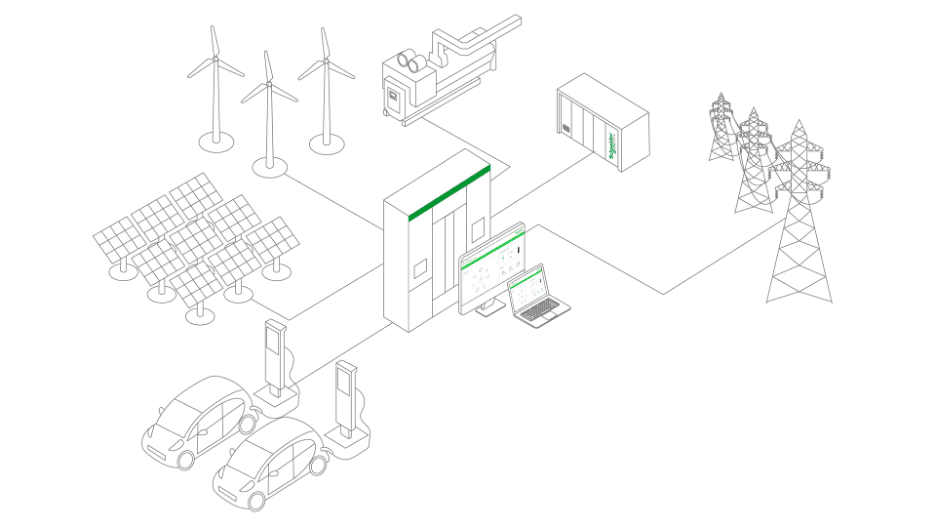Microgrids are becoming an increasingly important tool for commercial and industrial enterprises. By generating and storing power on-site, organizations are becoming more efficient, resilient and self-reliant, making them better able to withstand the impacts of volatile energy costs and frequent grid outages.

In many cases, microgrid implementation also significantly reduces carbon emissions, making it a key component to progress toward net-zero emissions goals.
Until now, microgrids have required so much time and investment that, in most cases, only large enterprises could deploy them. Every microgrid is a snowflake — unique and custom-engineered for the situation. The systems are largely custom-engineered and incorporate different software, hardware, and interface systems to meet the unique specifications for each build.
This creates a complex setup that could require multiple contractors, up to two or three years to implement, and a potentially lengthy utility interconnection process before it runs. The disjointed nature and complexity of installation can affect the ROI projection to not be beneficial for some time.
EcoStruxure Microgrid Flex brings standardization to the industry
Microgrids must be standardized, repeatable, and quick to configure for each use case to grow adoption and impact for enterprises, buildings, and facilities of all sizes. EcoStruxure Microgrid Flex is the first standardized solution for building and operating commercial and industrial microgrids.
Included are all the tools to design, build, commission, and operate a microgrid. And, because of standardization, they can be configured faster, using tested, validated, and documented architectures, along with accompanying hardware, software, and services.
From needs assessment to production, it shortens rollout times from years to months, significantly reducing overall costs. The customer can engage with one contractor for the entire deployment, then use standard software and services to operate it — with or without an on-site dedicated facilities manager to upskill. This significantly accelerates and enhances the ROI of a standardized microgrid implemented with EcoStruxure Microgrid Flex.
Rapid microgrid planning and deployment
Using a Schneider Electric cloud-based configuration tool, the customer, contractor, or designer makes selections based on the requirements of their site, such as electrical loads, distributed energy resources (DERs), utility grid connections, and time-of-use charges.
With those inputs, the configuration tool automatically generates a programmable logic controller (PLC) program for the planned microgrid, which can be uploaded to the microgrid controller onsite or given to a panel builder or manufacturer that will assemble the grid. Organizations have previously spent weeks or months to engineer microgrid configurations — now, with Schneider Electric’s new configuration tool, the process is sped up to a tiny fraction of that time.
Once the microgrid goes live, our EcoStruxure Microgrid Operation (EMO) on-site management software runs day-to-day operations and EcoStruxure Microgrid Advisor (EMA), a cloud-based, AI-powered analytics platform, enhances EMO’s capabilities by providing forecasts based on data from the microgrid and other sources.
In addition, the Energy Control Center, a pre-engineered power control center, manages energy sources to optimize resources and maximize performance. So, for example, if a weather forecast predicts a potentially disruptive storm, EMA can order the microgrid to charge up an onsite battery energy storage system (BESS). The standard microgrid configurations combine Schneider Electric and third-party components, including lithium-ion BESSes, solar photovoltaic inverters, and fuel-cell generators. Learn more.

Meeting varied needs through microgrid standardization
Initially, EcoStruxure Microgrid Flex is intended for small and medium-sized buildings with a vision to scale up and include other elements, such as EV charging stations, while remaining cost-effective.
The configurations can also serve a wide range of use cases, including:
- A microgrid permanently connected to the utility grid, comprising solar panels and a BESS, could reduce an enterprise’s energy costs. One that also included a fuel-cell generator could be “island-able” or capable of operating off the grid when necessary, further increasing resiliency.
- Alternatively, a customer operating entirely off-grid and looking to reduce generator fuel consumption could combine a generator with solar panels and a BESS.
Expanding the microgrid market
This standardization will create a market for the exponential growth of microgrid components and services as manufacturers and contractors enjoy increasing economies of scale.
Like lithium-ion batteries and countless other electronics products, microgrids will attract capital investment and innovation as costs fall and the market expands. These market forces will encourage the rapid introduction of distributed energy resources (DERs) and virtual power plants (VPPs), helping enterprises, utilities, and governments meet net-zero goals.
This growing microgrid industry will also require a skilled workforce to implement it. The Schneider Electric EcoXpert Microgrid Badge provides suppliers and technicians with a certification to establish their credentials in this emerging field and help grow their businesses.
This is a pivotal moment in the energy industry, opening up opportunities for enterprises of all sizes to take control of their energy future. Standardizing industrial and commercial microgrids is a significant step toward making this possible, an ambitious mission that requires the strengths Schneider Electric brings to the table. It calls for a company with years of experience in power engineering, manufacturing, innovation, and partnership. This is a game-changer for thousands of enterprises and sites that have been left out of the benefits of microgrids in the past.
With EcoStruxure Microgrid Flex, we are laying the groundwork for energy security and sustainability far into the future.
Learn more about Schneider Electric’s work to standardize microgrids with Microgrid Flex.



